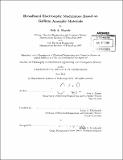| dc.contributor.advisor | Leslie A. Kolodziejski. | en_US |
| dc.contributor.author | Shamir, Orit A | en_US |
| dc.contributor.other | Massachusetts Institute of Technology. Dept. of Electrical Engineering and Computer Science. | en_US |
| dc.date.accessioned | 2012-12-13T18:49:09Z | |
| dc.date.available | 2012-12-13T18:49:09Z | |
| dc.date.copyright | 2012 | en_US |
| dc.date.issued | 2012 | en_US |
| dc.identifier.uri | http://hdl.handle.net/1721.1/75649 | |
| dc.description | Thesis (Ph. D.)--Massachusetts Institute of Technology, Dept. of Electrical Engineering and Computer Science, 2012. | en_US |
| dc.description | Cataloged from PDF version of thesis. | en_US |
| dc.description | Includes bibliographical references (p. 163-171). | en_US |
| dc.description.abstract | Optical Arbitrary Waveform Generation (OAWG) combines frequency combs and frequency-by- frequency pulse shapers to synthesize optical waveforms. The OAWG technique has a wide variety of applications, ranging from high resolution imaging, Light Detecting and Ranging (LIDAR) systems for high precision distance measuring, high-speed communication networks, and high capacity transmission systems. Frequency combs, generated by Ti:Sapphire mode-locked lasers, span the optical spectrum from A=0.65pm to 1.1pm and necessitate the development of compatible modulator devices which could be based on materials in the III-V semiconductor groups for the construction of an optical arbitrary waveform generation system. An OAWG system in the visible and near-infrared will motivate many novel applications yet to be envisioned, and will allow the transfer of technologies currently operating in the radio frequencies to the optical spectrum. The design of electrooptic ultra-broadband modulators operating at wavelengths longer than A=0.65ptm is investigated. Novel epitaxial heterostructures lattice-matched to GaAs - a p-i-n structure with a dilute core and a n-i-n Metal Oxide Semiconductor (MOS) heterostructure offering superior mode confinement - are modeled, and grown. The electric field distribution in the n-i-n MOS structure is examined through simulations and capacitancevoltage measurements. A Mach-Zehnder Interferometer modulator design is proposed, employing both multimode interferometers and Y-junctions as power splitters. A self-aligned fabrication mask set and process are developed and demonstrated, verifying the performance of the modulator epitaxial heterostructures through the demonstration of waveguiding and optical power splitting. A mask set is offered for improved processing yield and a fabrication process is designed to enable push-pull operation of the n-i-n MOS modulator. | en_US |
| dc.description.statementofresponsibility | by Orit A. Shamir. | en_US |
| dc.format.extent | 171 p. | en_US |
| dc.language.iso | eng | en_US |
| dc.publisher | Massachusetts Institute of Technology | en_US |
| dc.rights | M.I.T. theses are protected by
copyright. They may be viewed from this source for any purpose, but
reproduction or distribution in any format is prohibited without written
permission. See provided URL for inquiries about permission. | en_US |
| dc.rights.uri | http://dspace.mit.edu/handle/1721.1/7582 | en_US |
| dc.subject | Electrical Engineering and Computer Science. | en_US |
| dc.title | Broadband electrooptic modulators based on gallium arsenide materials | en_US |
| dc.type | Thesis | en_US |
| dc.description.degree | Ph.D. | en_US |
| dc.contributor.department | Massachusetts Institute of Technology. Department of Electrical Engineering and Computer Science | |
| dc.identifier.oclc | 818331384 | en_US |
